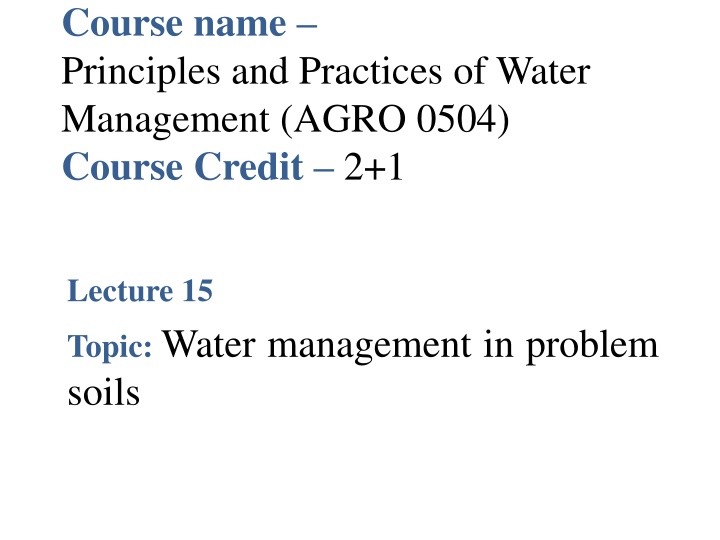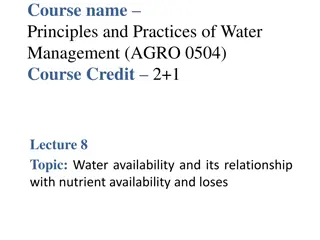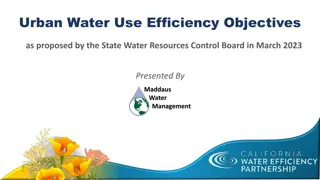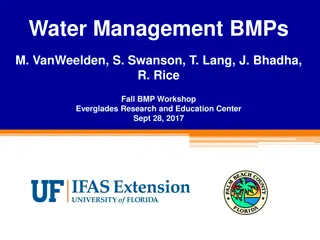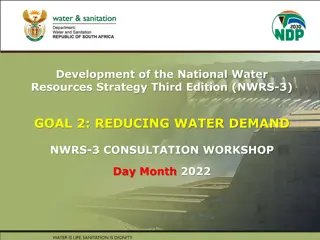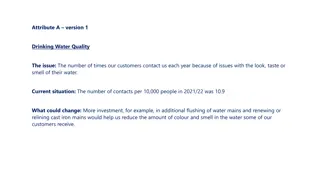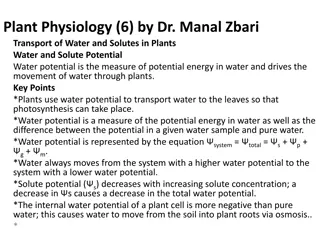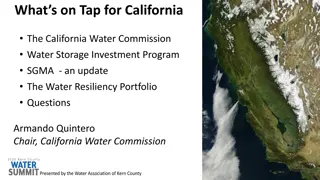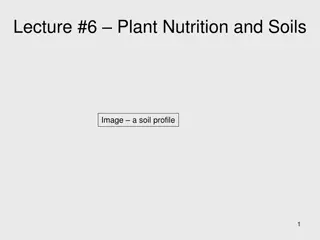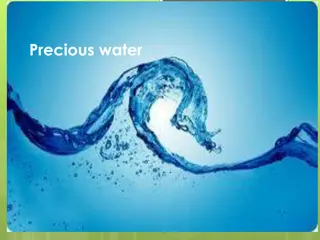Water Management in Problem Soils
The accumulation of soluble salts in arid and semi-arid regions due to poor water management can adversely affect crop production. Factors such as arid climate, high subsoil water table, poor drainage, and quality of irrigation water contribute to the development of salty soils. Learn about the causes, classification, and reclamation techniques for addressing soil chemical problems associated with salinity and alkalinity.
Download Presentation

Please find below an Image/Link to download the presentation.
The content on the website is provided AS IS for your information and personal use only. It may not be sold, licensed, or shared on other websites without obtaining consent from the author.If you encounter any issues during the download, it is possible that the publisher has removed the file from their server.
You are allowed to download the files provided on this website for personal or commercial use, subject to the condition that they are used lawfully. All files are the property of their respective owners.
The content on the website is provided AS IS for your information and personal use only. It may not be sold, licensed, or shared on other websites without obtaining consent from the author.
E N D
Presentation Transcript
Course name Principles and Practices of Water Management (AGRO 0504) Course Credit 2+1 Lecture 15 Topic:Water management in problem soils
Water management in problem soils When rocks and weathering process large quantities of soluble salts are formed. In humid regions these salts are washed down to the ground water and to the sea. But in arid and semi arid regions they accumulate in the soil. Excessive irrigation and poor water management are the two chief causes of water logging and salt accumulation. An accumulation of salts in soil leads to unfavourable soil water-air relationship and effect the crop production. minerals under go
The main causes which leads to development of salty soils (salinity or alkalinity) 1. Arid climate About 25% of earth surface is arid in which salt accumulation is a common problem. In India about 25 million hectare is salt affected with different degree of degradation. 2. High subsoil water table When the water table is with in capillary range, the water containing soluble salts rises to surface. When the water evaporates the salts encrustation. It is estimated that in Punjab annually about 50,000 acres becomes saline because of raising water table. are deposited as
3. Poor drainage Due to poor drainage accumulation of water leads to water logging condition which leads to salt accumulation. 4. Quality of irrigation water Irrigation water containing more than permissible quantities of soluble salts with sodium bicarbonates make the soil salty. 5. Inundation with sea water In coastal area, periodical inundation of land by sea water during high tides makes soil salty. Besides deep bore wells are also the reason for saline soils. 6. Nature of parent rock minerals The saline nature of parent rock minerals leads to salt accumulation 7. Seepage form canals The continuous seepage leads to salt accumulation. carbonate and
Classification of problem soils The soil problems can also be divided into a) Chemical b) Physical
Soil Chemical Problem The salt affected soils can be classified based on their ESP, pH and EC as follows. Reclamation of Alkali soil By converting exchangeable sodium into soluble salts by adding the following amendments. 1. Calcium chloride 2. Calcium sulphate (Gypsum) 3. Sulphuric acid 4. Ferrous sulphate 5. Aluminum sulphate Reclamation of Saline alkali soil Reclamation of Saline soil Leaching or flushing with good quality of water provided there will not be water logged condition i.e. good drainage system should be there to flush water. Reclamation of Saline alkali soil The reclamation of these soils is similar to that of alkali soils. First step is to remove the exchangeable sodium and then the excess salts and sodium are to be leached out. Commonly salt affected soils are referred as problem soils as indicated above. Further, based on pH value it can also be grouped as acid soils where the pH value is less than 7.
Management practices for chemical problems of soil Reclamation of saline and alkali soils are not complete unless proper remedial measures are under taken to restore the soil fertility and structure of the soil. The following are the important management practices to overcome there problems. The saline soil can be easily improved with leaching of salts by using of god quality water and by providing good drainage systems. Application of gypsum would improve the permeability of soil by making good soil aggregates In acidic soils, lime application should be adequate and excessive leaching should be avoided Salt resistant or saline resistant species should be selected for cultivation Application of amendments viz gypsum and press mud is found to suppress the sodium and chromium content in plant and soil. Growing resistant crops like ragi cotton, barley and rice can be advocated. Growing green manure crops like sunnhemp, daincha and kolinji can be advocated. Growing resistant varieties like CoC 771 in sugarcane Co 43 in rice may be made. Adoption of drip irrigation for possible crop is also recommended to over come soil physical and chemical problems. Liberal application of FYM Application of green manure Excess phosphorous and application Proper drainage to keep the soil without adverse effect to plant systems.
Soil physical problems Very coarse, very clayey texture, shallow depth and encrustation in soil surface are the possible physical problems. Too frequent irrigation in clayey soils with very high water retention results in poor drainage, water logging and crop damage. Excess irrigation or heavy rain create hardening of soil surface in red latritic soils with high Fe and Al hydroxides and low organic matter. This leads to poor germination, restriction of shoot and development and slow entry of water into the soil profile
